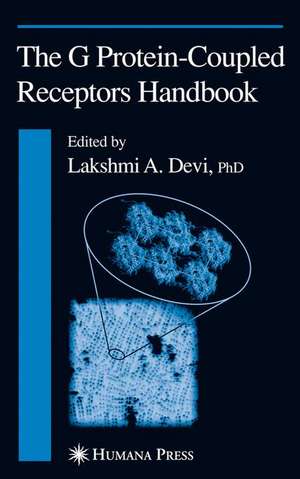The G Protein-Coupled Receptors Handbook: Contemporary Clinical Neuroscience
Editat de Lakshmi A. Devien Limba Engleză Hardback – mai 2005
| Toate formatele și edițiile | Preț | Express |
|---|---|---|
| Paperback (1) | 1055.53 lei 38-44 zile | |
| Humana Press Inc. – dec 2010 | 1055.53 lei 38-44 zile | |
| Hardback (1) | 1231.01 lei 6-8 săpt. | |
| Humana Press Inc. – mai 2005 | 1231.01 lei 6-8 săpt. |
Din seria Contemporary Clinical Neuroscience
- 5%
 Preț: 655.43 lei
Preț: 655.43 lei - 18%
 Preț: 958.25 lei
Preț: 958.25 lei - 18%
 Preț: 1678.01 lei
Preț: 1678.01 lei - 18%
 Preț: 1403.22 lei
Preț: 1403.22 lei - 18%
 Preț: 1008.43 lei
Preț: 1008.43 lei - 5%
 Preț: 1407.87 lei
Preț: 1407.87 lei - 18%
 Preț: 1101.40 lei
Preț: 1101.40 lei - 18%
 Preț: 944.19 lei
Preț: 944.19 lei - 5%
 Preț: 1105.95 lei
Preț: 1105.95 lei - 15%
 Preț: 644.30 lei
Preț: 644.30 lei - 5%
 Preț: 1173.82 lei
Preț: 1173.82 lei - 15%
 Preț: 641.03 lei
Preț: 641.03 lei - 18%
 Preț: 1239.19 lei
Preț: 1239.19 lei - 18%
 Preț: 1229.40 lei
Preț: 1229.40 lei - 18%
 Preț: 1110.24 lei
Preț: 1110.24 lei - 18%
 Preț: 1113.39 lei
Preț: 1113.39 lei - 18%
 Preț: 1225.94 lei
Preț: 1225.94 lei - 5%
 Preț: 1438.58 lei
Preț: 1438.58 lei - 15%
 Preț: 651.84 lei
Preț: 651.84 lei - 5%
 Preț: 1103.22 lei
Preț: 1103.22 lei - 18%
 Preț: 1402.55 lei
Preț: 1402.55 lei - 5%
 Preț: 1089.48 lei
Preț: 1089.48 lei - 18%
 Preț: 1828.60 lei
Preț: 1828.60 lei - 5%
 Preț: 1103.75 lei
Preț: 1103.75 lei - 18%
 Preț: 1407.46 lei
Preț: 1407.46 lei - 18%
 Preț: 951.47 lei
Preț: 951.47 lei - 18%
 Preț: 1385.37 lei
Preț: 1385.37 lei
Preț: 1231.01 lei
Preț vechi: 1501.23 lei
-18% Nou
Puncte Express: 1847
Preț estimativ în valută:
235.59€ • 245.04$ • 194.49£
235.59€ • 245.04$ • 194.49£
Carte tipărită la comandă
Livrare economică 14-28 aprilie
Preluare comenzi: 021 569.72.76
Specificații
ISBN-13: 9781588293657
ISBN-10: 1588293653
Pagini: 432
Ilustrații: XVI, 412 p. 56 illus., 9 illus. in color.
Dimensiuni: 178 x 254 x 29 mm
Greutate: 0.83 kg
Ediția:2005
Editura: Humana Press Inc.
Colecția Humana
Seria Contemporary Clinical Neuroscience
Locul publicării:Totowa, NJ, United States
ISBN-10: 1588293653
Pagini: 432
Ilustrații: XVI, 412 p. 56 illus., 9 illus. in color.
Dimensiuni: 178 x 254 x 29 mm
Greutate: 0.83 kg
Ediția:2005
Editura: Humana Press Inc.
Colecția Humana
Seria Contemporary Clinical Neuroscience
Locul publicării:Totowa, NJ, United States
Public țintă
ResearchCuprins
GPCRs: Structure and Function.- Structure—Function Relationships in G Protein-Coupled Receptors.- Molecular Mechanisms Involved in the Activation of Rhodopsin-Like Seven-Transmembrane Receptors.- GPCR Folding and Maturation.- Regulated Membrane Trafficking and Proteolysis of GPCRs.- GPCR Activity and Its Regulators.- Heterotrimeric G Proteins and Their Effector Pathways.- RGS Proteins.- G Protein-Coupled Receptor Kinases.- Regulators of GPCR Activity.- GPCR Interacting Proteins.- GPCR Dimerization/Oligomerization.- Biophysical and Biochemical Methods to Study GPCR Oligomerization.- Oligomerization Domains of G Protein-Coupled Receptors.- Functional Complementation and the Analysis of GPCR Dimerization.- The Role of Oligomerization in G Protein-Coupled Receptor Maturation.- Receptor Oligomerization and Trafficking.- Modulation of Receptor Pharmacology by G Protein-Coupled Receptor Dimerization.- Recent Developments in Drug Discovery.- Role of Heteromeric GPCR Interactions in Pain/Analgesia.- Conformational Plasticity of GPCR Binding Sites.- De-Orphanizing GPCRs and Drug Development.
Recenzii
"...provides an excellent resource to introduce the reader to many of the diverse areas and questions that drive research in the GCPR field." -TRENDS in Endocrinology and Metablosim
Textul de pe ultima copertă
G protein-coupled receptors (GPCRs) are involved in many processes in the human body relevant to health and disease, and consequently are the targets of approximately 70% of pharmacological therapeutics and a major source of new drug candidates. In The G Protein-Coupled Receptors Handbook, leading academic researchers comprehensively survey the many recent advances that have occurred in the GPCR field. The authors describe the current knowledge of GPCR receptor structure and function, the different mechanisms involved in the regulation of GPCR function, and the role of pharmacological chaperones in GPCR folding and maturation. They present new findings about how GPCR dimerization/oligomerization modifies the properties of individual receptors, and show how recent developments are leading to significant advances in drug discovery. They also discuss the most recent developments that could lead to new discoveries: the role of GPCRs in mediating pain, the development of receptor-type selective drugs based on the structural plasticity of receptor activation, and the identification of natural ligands of orphan GPCRs (deorphanization) as possible drug targets.
Authoritative and cutting-edge, The G Protein-Coupled Receptors Handbook offers pharmacologists, biochemists, and neuroscientists an exhaustive review of the progress made in understanding how GPCRs are activated and regulated, key factors in exploiting GPCRs for drug development.
Authoritative and cutting-edge, The G Protein-Coupled Receptors Handbook offers pharmacologists, biochemists, and neuroscientists an exhaustive review of the progress made in understanding how GPCRs are activated and regulated, key factors in exploiting GPCRs for drug development.
Caracteristici
Includes supplementary material: sn.pub/extras















